Now, let’s apply what you’ve learned to a patient.
She is an 80-year-old female who presents to the ED via ambulance from an assisted living facility. She complains of difficulty breathing, is using accessory muscles, and complains of shortness of breath. Her BNP is elevated, indicating congestive heart failure. Assessment of her breath sounds reveal rales or crackles bilaterally halfway up the lower lung fields. Her oxygen saturation is low at 89 percent. She sits in a Fowler position, unwilling to lie supine. She is able to reposition herself in the bed, but ambulation produces severe shortness of breath. The chest radiograph reveals an enlarged cardiac shadow with consolidation in both lower lung fields. Diuresis is ordered along with an indwelling urinary catheter.
Slide 136
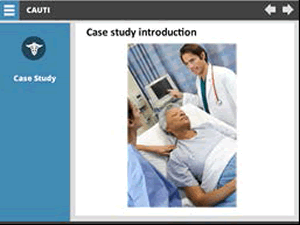
Case study introduction
Image of an elderly woman in a hospital bed being attended to by healthcare professionals.
Slide 137
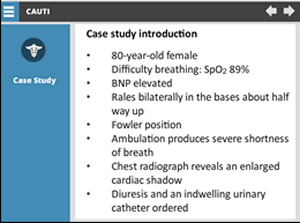
Case study introduction
- 80-year-old female
- Difficulty breathing: SpO2 89%
- BNP elevated
- Rales bilaterally in the bases about halfway up
- Fowler position
- Ambulation produces severe shortness of breath
- Chest radiograph reveals an enlarged cardiac shadow
- Diuresis and an indwelling urinary catheter ordered.
Let’s examine her clinical situation and whether the order for a urinary catheter is appropriate.
She is demonstrating severe congestive heart failure. She is clearly in need of fluid removal to improve her mobility and cardiac function, and to prevent complications from excess fluid.
Does diuresis always mean a catheter is necessary?
Slide 138
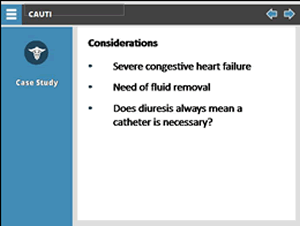
Considerations
- Severe congestive heart failure
- Need of fluid removal
- Does diuresis always mean a catheter is necessary?
The attending physician has ordered furosemide and an indwelling urinary catheter. Is this the most appropriate action in this case?
Slide 139
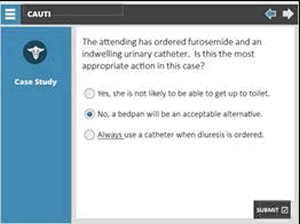
The attending has ordered furosemide and an indwelling urinary catheter. Is this the most appropriate action in this case?
You may select one of these choices: Yes, she is not likely to be able to get up to toilet; No, a bedpan will be an acceptable alternative; or Always use a catheter when diuresis is ordered.
She is able to reposition herself on the stretcher, so a bedpan may be an acceptable alternative. She is not likely to be able to get up to toilet, as her ability to ambulate is limited. However, with planning and preparation, a catheter may be unnecessary for her.
Since the order has already been written, how will you address your concerns to the attending physician? Enter your answer on to the clipboard on the left of your screen. After you have finished, click submit.
Slide 140
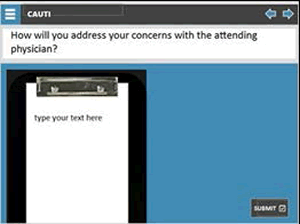
How will you address your concerns with the attending physician?
Screen shot of a clipboard with a sheet paper with the graphic saying "type your text here".
Slide 141
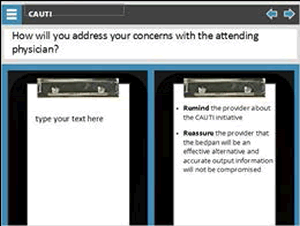
How will you address your concerns with the attending physician?
Screen shot of a clipboard with a sheet paper with the graphic saying "type your text here". Also screen shot of a clipboard with a sheet of paper with the graphic on right saying:
- Remind the provider about the CAUTI initiative
- Reassure the provider that the bedpan will be an effective alternative and accurate output information will not be compromised
Remind the provider that there is a national initiative to reduce the use of catheters in order to prevent CAUTI. Reassure the provider that with planning and preparation, the bedpan will prove an effective alternative to a catheter, and obtaining accurate output information will not be compromised. As we have discussed, elimination and output is within the realm of the nurse, and when explained well, and responsibility accepted, the provider is likely to agree.
Before the expected response to the diuretic becomes urgent, plans for toileting will be included in communications with the patient care technician in order to prevent incontinence. Ideally, the technician is included in the goal of reducing catheter usage and CAUTI, and will understand the reasons behind the decision.
Following the administration of furosemide, the patient voids 1200 mL of clear, pale yellow urine. Her breath sounds are now clear throughout, oxygen saturation has improved, the work of breathing has lessened, and she is now much more comfortable.
The nurse prepares her for admission to the medical unit.
In handing off the patient to the admitting nurse, review the rationale for not placing a urinary catheter. Review the decision in light of acceptable alternatives and the needs of the patient.
Ideally, the inpatient units will have their own process for reducing catheter insertions and CAUTIs. If not, relate the evidence and the protocol in place in the ED.
Next, match the terms of beneficence and non-maleficence to the proper rationale for not using an indwelling urinary catheter that you could report to the inpatient nurse during handoff.
Slide 142
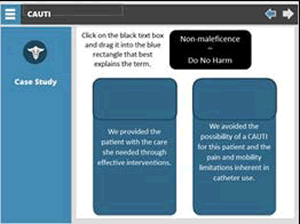
Click on the black text box and drag it into the blue rectangle that best explains the term.
Black text box reads "non-maleficence -- Do No Harm.
Blue rectangle on left reads "We provided the patient with the care she needed through effective intervention." Blue rectangle on right reads "We avoided the possibility of a CAUTI for this patient and the pain and mobility limitations inherent in catheter use.
| Drag Item | Drop Target |
|---|---|
| Beneficence
~ Do Good |
Rectangle 5 |
| Non-maleficence
~ Do No Harm |
Rectangle 6 |
Applying the ethical principle of beneficence to this case, we provided the patient with the care they needed through effective interventions.
Considering the ethical principle of non-maleficence, we avoided the possibility of a CAUTI for this patient and the pain and mobility limitations inherent in catheter use.
Slide 143
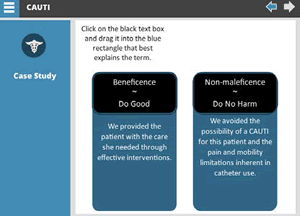
Top area says: Click on the black text box and drag it into the blue rectangle that best explains the term. The left rectangle has the following text: Beneficence ~ Do Good. We provided the patient with the care she needed through effective interventions. Right rectangle has the following text: Non maleficence ~ Do No Harm. We avoided the possibility of a CAUTI for the patient and the pain and mobility limitations inherent in catheter use.



